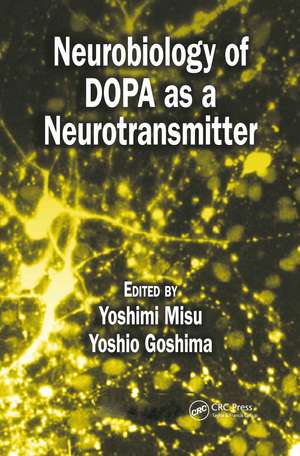Neurobiology of DOPA as a Neurotransmitter
Editat de Yoshimi Misu, Yoshio Goshimaen Limba Engleză Hardback – noi 2005
The book begins with a historical review of current knowledge of DOPA. It characterizes DOPA as a prominent example showing transmutation from an inert substance to a gold drug in Parkinson's disease and further to a neurotransmitter in its own right. The next chapters cover the essential criteria of a neurotransmitter such as synthesis, existence, and competitive antagonism. The book describes metabolism composed of catecholamine synthesis and degradation products related to neuron death, physiological release of DOPA in the lower brainstem, striatum, and nucleus accumbens, and physiological or pharmacological responses involved in baroreflex neurotransmission and related to behavioral science including interactions with catecholamines, acetylcholine, glutamate, and GABA. The book explores recognition sites, transport sites, and therapeutic role and mechanisms for neuron death related to adverse influence in the treatment of Parkinson's Disease.
Edited by experts in the field, the breadth and depth of information contained in this book is confirmed by a quick scan of the chapter authors. They summarize the issues surrounding DOPA neurotoxicity and explore the link between experimental studies and clinical relevance.
Preț: 1280.09 lei
Preț vechi: 1557.80 lei
-18% Nou
Puncte Express: 1920
Preț estimativ în valută:
244.95€ • 256.39$ • 203.87£
244.95€ • 256.39$ • 203.87£
Comandă specială
Livrare economică 10-24 martie
Doresc să fiu notificat când acest titlu va fi disponibil:
Se trimite...
Preluare comenzi: 021 569.72.76
Specificații
ISBN-13: 9780415332910
ISBN-10: 0415332915
Pagini: 408
Ilustrații: 91 b/w images, 14 tables and 14 halftones
Dimensiuni: 156 x 234 x 26 mm
Greutate: 0.73 kg
Ediția:1
Editura: CRC Press
Colecția CRC Press
Locul publicării:Boca Raton, United States
ISBN-10: 0415332915
Pagini: 408
Ilustrații: 91 b/w images, 14 tables and 14 halftones
Dimensiuni: 156 x 234 x 26 mm
Greutate: 0.73 kg
Ediția:1
Editura: CRC Press
Colecția CRC Press
Locul publicării:Boca Raton, United States
Public țintă
ProfessionalCuprins
History. Biosynthesis, Metabolism, Active Transport, and Existence. Release. Pharmacology. Neurotoxicology. Index.
Recenzii
"…a highly detailed review of antipsychotic drugs and neuroreceptors. There are many reviews of psychopharmacology, but this is one of the most specialized and exhaustive I have read. Any clinician or researcher interested in antipsychotic medications would find it a useful addition to their library."
-William Miles, M.D., Rush-Presbyterian-St. Luke's Medical Center
"The editors have succeeded well in their objective: to begin bridge the gap between the lab and the clinic. Dopamine, dopamine receptors, and dopamine transport lie at the core of important human disorders such as schizophrenia and Parkinson's disease. 4 Stars!"
- Daniel B. Hier, MD, University of Illinois at Chicago College of Medicine, for Doody's Review
"… present a timely overview of the different aspects of this amino acid in neurotransmission. … written by over 40 leading experts … a must-read for every neuroscientist working on endogenous neurotransmitters."
– Karl Gademann, Switzerland in ChemMedChem, 1, 2006
-William Miles, M.D., Rush-Presbyterian-St. Luke's Medical Center
"The editors have succeeded well in their objective: to begin bridge the gap between the lab and the clinic. Dopamine, dopamine receptors, and dopamine transport lie at the core of important human disorders such as schizophrenia and Parkinson's disease. 4 Stars!"
- Daniel B. Hier, MD, University of Illinois at Chicago College of Medicine, for Doody's Review
"… present a timely overview of the different aspects of this amino acid in neurotransmission. … written by over 40 leading experts … a must-read for every neuroscientist working on endogenous neurotransmitters."
– Karl Gademann, Switzerland in ChemMedChem, 1, 2006
Descriere
Providing a summary of recent research, this book makes the case that DOPA meets many of the criteria of neurotransmitters. It begins with a historical review, followed by a look at the essential criteria of a neurotransmitter. Experts in the field summarize the issues surrounding DOPA neurotoxicity and explore the link between experimental studies and clinical relevance. They examine metabolism with regard to catecholamine synthesis, and degradation products related to neuron death. They also discuss recognition and transport sites, the physiological release of DOPA, responses involved in baroreflex neurotransmission, and interactions with catecholamines, acetylcholine, glutamate, and GABA.
